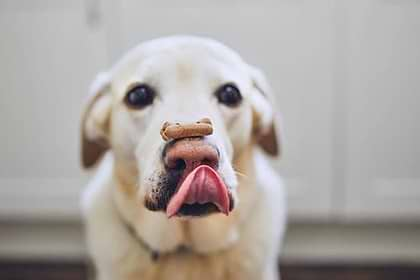Every dog should be taught how to greet people politely—it’s simply good manners! But for a large breed pup, proper greetings are essential. Nobody wants muddy paw prints on their clothes or to be thumped in the chest by two huge paws. If you allow your large dog to jump on people, it can frighten your guests. Or even worse, your enthusiastic pup could knock someone over and injure them. We know you want to teach your dog a better way to say hello, so here are some tips and tricks to stop your dog from jumping on you and your visitors.
Your Dog Just Wants to Say Hello
Dogs don’t jump to be pushy or rude. They just want to say hi face to face. Plus, jumping is a sure-fire way to get human attention. It’s hard to ignore a pup who is leaping all over you! Because dogs repeat behaviors that are rewarding, and human attention is a wonderful reward, you can expect your dog to continue jumping if it gets them what they want. For most dogs, even negative attention is better than nothing. So, yelling, pinching paws, or shoving your dog away can actually reinforce the behavior.
To truly eliminate jumping, your dog should never be rewarded for it. That means ignoring your dog whenever they jump. Be consistent with your rules. It’s too confusing if you allow jumping on weekends when you’re in your jeans but forbid it during the week when you’re in your best suit. Even guests and strangers on the street should ignore your dog when they jump. It’s hard to control other people, though, and it’s far easier to manage greeting situations when you teach your dog an alternative way to say hello.
Manage Greetings
Management and a bit of planning can help you prevent excessive jumping. First, consider the situations that cause the behavior. Is it guests at the door? When you get home from work? Or when you encounter people on your walks? Whatever the case, your next step is to develop a management strategy.
For example, a baby gate can keep your dog away from the front door. Or if company is coming, crate your dog for the visit, at least for the first few minutes when excitement is high. Only release them once they are calm and ready to behave. Another option is to keep toys by the front door. As soon as you or your visitors arrive, toss the toy into another room for your dog to chase.
Try The “Four on the Floor” Game
You can also use treats to manage your dog’s behavior when you come home, when guests arrive, or when you’re out on walks. Have a pouch of goodies at the ready so you can toss food on the floor before your pup can even think of jumping. While they’re busy sniffing the ground, you or your guests can greet and pet them. This isn’t just great for greeting management; it also rewards your dog for keeping all four feet on the floor in the presence of people. The trick is to toss the food early enough. If your dog has already jumped, you’re too late and are now rewarding jumping. As your dog catches on to the game, you can delay tossing the food until after the greeting and then begin to reduce the number of treats you give.
Teach Your Dog an Alternative Behavior
It’s not enough to prevent your pup from jumping, you need to teach them an alternative way to greet people. If they don’t know how to earn the attention they seek, it will frustrate and confuse them.
How your dog says hello is up to you! You might simply want all four paws on the floor as in the treat tossing technique above. Or, maybe you want your dog to go to their crate whenever the doorbell rings. Whatever your rules, set up your training conditions so your dog can succeed.
Let’s use sit for greetings as an example. Start in a quiet room with no distractions. Place your dog on a leash and tether them to a doorknob or heavy piece of furniture. Walk about ten feet away, then ask your dog to sit. As soon as their bum hits the floor, calmly approach them. If they stay sitting, walk right up to them and give them some gentle pats, quiet praise, and a few treats. If they stand up or jump toward you, walk back to your starting position and ask for a sit again. Repeat until your pup will reliably stay seated for your greeting. Through this technique, they’re learning that sitting makes good things happen and jumping gets them nowhere.
Next, make the exercise a bit more challenging. Repeat the steps above, but this time be more enthusiastic. Continue to build your energy level until you can run up to your dog while calling in a high-pitched voice. (This is great practice for when your dog greets children!) If your dog truly understands that their behavior controls your greeting, they will keep their butt glued to the ground.
Now repeat this process with friends or family members taking the role of greeter. When your dog will sit for other people they know, you’re ready to take your training to the front door. Again, go back to step one and work your way through the entire process. The final step is working with strangers outside. If your dog has a strong understanding of what you expect and a long history of reinforcement, you have a better chance of success. But be sure to tell strangers the rules for greeting so they don’t inadvertently reward jumping.
Stopping your large breed pup from jumping on people can be challenging for every pet parent. We hope these tips will help you teach your furry friend to say hello in a more appropriate way. With consistency and patience, your dog will develop polite greeting behaviors that will last a lifetime!

Stephanie Gibeault
Stephanie Gibeault is a freelance writer and certified professional dog trainer with a Master of Science in animal behavior. She is passionate about combining her love of animals with her writing skills to educate and entertain. When she’s not at her keyboard, you can find her tap dancing, taking photographs, or tweeting (@GibeaultWrites).
You might also like
Crate training tips, stories and inspiration
View all blogsIn Your Diggs
Share your photos with #DiggsPet and tag us @DiggsPet on IG and TikTok.



